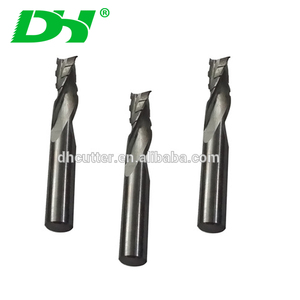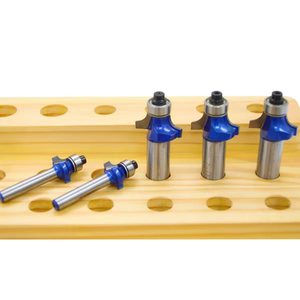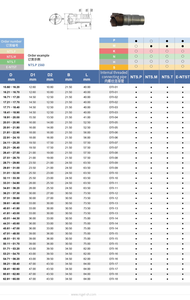
All categories
Featured selections
Trade Assurance
Buyer Central
Help Center
Get the app
Become a supplier

(21381 products available)













































Machine cutting tools are required to perform complicated operations and thus come in various cutting types. This variety ensures that one can select the most suitable for the material and the design requirements of any given task.
End mills are very common in machining, making rectangular holes and contours. They can be two up to six-flute cutting tools, and the flutes on these tools help remove the chips produced while cutting. Besides, unlike drilling bits, end mills cut in all directions. Thus, they can remove materials from both the flat and side cutting edges.
Taps are cutting tools used in making internal threads in holes. They come in various thread pitches and sizes to suit different threading requirements. Also, taps are part of making threaded fasteners by creating mating threads within the tapped holes.
Boring bars are applied when enlarging an already existing hole and improving its accuracy and surface finish. The tools come with cutting bits fixed on the bar itself, which is set in a machine for boring. Sliding parts of the boring tool enable the operator to adjust them for different depths by sliding parts of the boring tool.
A cutting tool would remove the material by rotating the workpiece, and the tool would act on it. The tool has a single-point design; it is primarily used to shape and cut materials, especially in lathe operations. This design makes it ideal for tasks involving external and internal threading.
Face mills are cutting tools used to create a flat surface on different materials. They consist of several insert cutters mounted on a larger fly cutter. The tool can remove a larger amount of material than end mills in a single pass.
Cutting bits for machines do not only differ in shape and size but also in industry applications. Understanding industries where these bits are used will help know the demand for cutting bits.
The machining process, in turn, depends on cutting bits to manufacture important engine and transmission parts. Such bits ensure precision machining needed for safety and performance components and reducing wear on the bits themselves while working on hard metals.
Parts of the aerospace industry, such as aircraft and spacecraft, require bits with very high precision. Aerospace makes bits for lightweight and durable materials like titanium and aluminum. These industries work with usually non-thermal conductive materials, which require cutting bits for machines that can withstand prolonged use with minimal heat generation.
Cutting bits play a crucial role in the production of numerous components in the manufacturing industry. The bit is used in making tools, machinery parts, and consumer goods. There is a demand for versatile cutting bits that can effectively work on materials ranging from plastics to metals.
The metalworking industry majorly relies on machine cutting bits. Here the bits are used to shape shear and drill metals to produce a variety of products. There is a demand for cutting tool inserts that can withstand the intense heat and friction generated when machining metals.
Tool and die industries require cutting bits to produce molds, dies, and cutting tools. These bits are required to create precise cutting tools like end mill bits for machines for making bending dies that will be used in the automotive industry stamping machines used in producing sheet metal components.
Material Composition
Machine cutting tools are made of steel, typically high-speed steel (HSS), carbide, cobalt-chromium alloy, or titanium-nitride coating). The materials give the bits a balance between toughness and durability.
Flute Design
The design of the flutes on the cutting bit influences the chip removal capability. Cutting bits have spiral or straight flutes, which can be single or multiple depending on the nature of the machining operation to be performed.
Bit Size and Geometry
Machine cutting bits are available in various sizes, which may range from a diameter of 0.5 mm to about 25 mm, depending on the machining needs. The geometry of the cutting edge, which includes the relief angle, rake angle, and cutting edge angle, influences the operation's effectiveness and efficiency.
Shank Compatibility
The shank design of the cutting bit is also important, as it must be compatible with the machine tool's holders. Machine cutting bits come with parallel or tapered shanks to fit different machines.
Coating
To enhance the wear resistance of the cutting bit, often, they are coated with materials like titanium nitride, diamond, or TiAlN. Coatings also improve the bit's cutting performance by reducing friction.
For one to derive the cutting bits' operational power, the machine must first get them installed properly.
Power Off the Machine
The machine has to be powered off before performing any task on it. This is for safety's sake and to ensure the equipment is not damaged in any way.
Remove Old Cutting Bit
If there are already cutting bits to remove, the machine should do that gently, so it doesn't get damaged. The removal method will depend on the type of machine; in some lathes and mills, you have to unscrew the holder to remove the old bits.
Clean the Holder
Once the old bits are removed, the bit holder or chuck should be cleaned of debris and residue. Cleaning reduces the old material's contamination and ensures solid new cutting bits are firmly attached.
Insert New Cutting Bit
Place the new cutting tool bit into the bit holder. Ensure the cutting end is positioned correctly for the task.
Secure the Bit
If the machine has a bit holder, ensure the bit is secured tightly. For machines with chucks, the chuck should be tightened to hold the bit securely in place.
Check Alignment
After securing the bit, check the alignment. Misalignment can cause uneven wear and poor-quality machining.
Test Run
Once the machine is powered up, there was a test run with low RPM to check the cutting bit's stability and alignment.
Maintenance and proper care for the machine tool cutting bits extend their useful life and operational efficiency.
Regular Cleaning
After every use, the machine should be cleaned to remove debris and chips from the cutting bit. Additionally, cutting lubricants or coolants residue could accumulate on the bit, affecting its cutting capability. A build-up of residue can cause the bit to rust or corrode, thus reducing its life span. Use a soft brush and a damp cloth to wipe cuttings material and lubricate the bit.
Lubrication
Lubricating the cutting bit helps reduce friction, overheating, and wear. Lubrication service should be done right after cleaning the machine when the bit is still relatively warm.
Sharpening
Regularly sharpening the cutting bits ensures they remain effective. Dull cutting bits tend to overheat, require more power, and result in poor-quality finishes. Sharpening can be done using a professional sharpening service or an in-house sharpening tool like a bench grinder, a sharpening wheel, or an abrasive stone.
Regular Inspections
Constant inspection helps determine how worn out a bit is and whether it needs to be replaced. In the course of regular inspection, cutting bits should be checked for visible signs of wear, like chipping, cracking, or breaks having sharp edges. Also, listen for unusual sounds coming from the bit while machining, as this could indicate mechanical issues.
Proper Storage
For a cutting bit to last long, it should be properly stored when not in use. The storage medium should protect the bit from impacts, moisture, and other environmental factors that could result in wear or corrosion.
Rotation of Bits
If possible, rotate the bits to ensure even wear. This means using each bit in the set equally.
Material Quality
The material used to make the cutting bit greatly influences its durability, toughness, and cutting ability. Cutting bits made of high-speed steel carbide or cobalt alloys retain sharpness longer and withstand high temperatures. Often, these materials are generally harder, making them suited for cutting a wider range of materials.
Brand Reputation
Brand reputation is one of the recommended quality factors. Well-decorated manufacturers have established standards in engineering and usually undergo rigorous testing of their products. Customers get to know such brands, and therefore, their products are trusted and used around the globe. They provide quality customer support, which is very vital.
Flute Design
Chip removal capability and the efficiency of the cutting bit depend on the design of the flutes. The quality cutting bits feature well-designed flutes that improve the bit's performance by enhancing chip removal. This, in turn, prevents clogging and allows better cutting.
Edge Retention
Edge retention is a critical quality consideration for machine cutting bits. Good-quality bits must ensure they don't dull quickly with continuous use. This factor usually ties with the material of the bit and the manufacturing technique used to produce it. Bits with enhanced retention of edge will require less frequent sharpening and offer better finishes in the function of machining.
Heat Resistance
During cutting operations, the more the friction, the more the heat generated. Heat resistance is very crucial, as excessive heat might dull or weaken the cutting bit, especially under heavy cutting operations. This feature is a mark of quality, as the quality bit has good heat resistance.
Testing and Certification
Quality assurance measures commonly include rigorous testing and certification processes. Many quality bits undergo standardized machining trials to evaluate their performance in terms of cutting speed, wear rate, and surface finish. These tests usually certify the bits meet industry standards like ISO or ANSI.
Customer Reviews and Feedback
Customer feedback generally provides valuable insights into long-term performance. Reviews usually address such issues as durability, consistency of the quality of machining, and manufacturer's support. They also gauge the quality of the bit.
Quality is affected by the material of the bit, the brand's reputation, the design of the flutes, the heat resistance of the bit, and various quality testing and certification measures. Care and maintenance also affect the bit's quality. Machine cutting tool holders should be replaced when there are visible signs of wear, such as chipping or cracking, or when they have dulled so much that normal sharpening can't restore their cutting capability. Other signs include overheating during operations, which indicates excessive friction due to a worn-out cutting edge.
Some of the visible physical signs of wear include chipping or cracking, tooling wear, heat damage, and rust or corrosion. Dull cutting bits will also produce poor-quality finishes or require more force, which might damage the machine.
Coating helps enhance the wear resistance of the cutting bit. Coating applied to the cutting bit improves the bit's cutting performance by reducing friction. Therefore, this prolongs the life of the bit.
Regularly cleaning the bit after use and using lubricating oils or coolants are the most common techniques. Also, there is a technique called "Pecking" in which the cutting depth in each pass is limited, reducing the amount of material removed in a single cut, hence generating less heat.
Cutting bits for machines should be made of strong materials like high-speed steel, carbide, and cobalt since these materials retain sharpness for a long duration and can withstand high-temperature friction during cutting operations. Regular maintenance, such as cleaning and sharpening, will help the bit lose its edge and dull faster. Storing the bit in a dry place will prevent it from rusting.